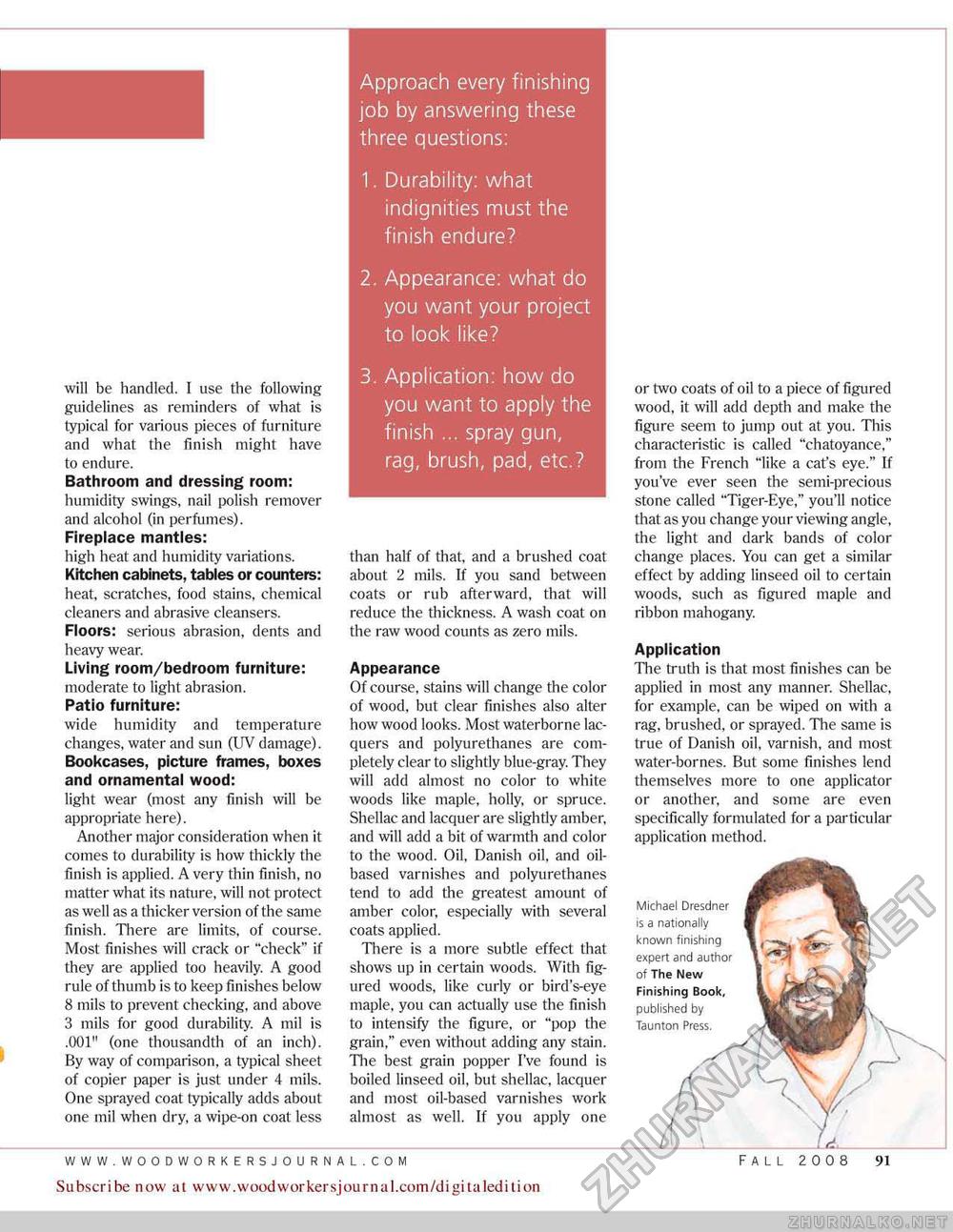Woodworker's Journal fall-2008, страница 91
Approach every finishing job by answering these three questions: 1. Durability: what indignities must the finish endure? 2. Appearance: what do you want your project to look like? 3. Application: how do you want to apply the finish ... spray gun, rag, brush, pad, etc.? will be handled. 1 use the following guidelines as reminders of what is typical for various pieces of furniture an d wh at the finish might h ave to endure. Bathroom and dressing room: humidity swings, nail polish remover and alcohol (in perfumes). Fireplace mantles: high heat and humidity variations. Kitchen cabinets, tables or counters: heat, scratches, food stains, chemical cleaners and abrasive cleansers. Floors: serious abrasion, dents and heavy wear. Living room/bedroom furniture: moderate to tight abrasion. Patio furniture: wide humidity and temperature changes, water and sun (UV damage). Bookcases, picture frames, boxes and ornamental wood: light wear (most any finish will be appropriate here). Another major consideration when it comes to durability is how thickly the finish is applied. A very thin finish, no matter what its nature, will not protect as well as a thicker version of the same finish. There are limits, of course. Most finishes will crack or "check" if they are applied too heavily. A good rule of thumb is to keep finishes below 8 mils to prevent checking, and above 3 mils for good durability. A mil is .001" (one thousandth of an inch). By way of comparison, a typical sheet of copier paper is just under 4 mils. One sprayed coat typically adds about one mil when dry, a wipe-on coat less than half of that, and a brushed coat about 2 mils. If you sand between coats or rub afterward, that will reduce the thickness. A wash coat on the raw wood counts as zero mils. Appearance Of course, stains will change the color of wood, but clear finishes also alter how wood looks. Most waterborne lacquers and polyurethanes are completely clear to slightly blue-gray. They will add almost no color to white woods like maple, holly, or spruce. Shellac and lacquer are slightly amber, and will add a bit of warmth and color to the wood. Oil, Danish oil, and oil-based varnishes and polyurethanes tend to add the greatest amount of amber color, especially with several coats applied. There is a more subtle effect that shows up in certain woods. With figured woods, like curly or bird's-eye maple, you can actually use the finish to intensify the figure, or "pop the grain," even without adding any stain. The best grain popper I've found is boiled linseed oil, but shellac, lacquer and most oil-based varnishes work almost as well. If you apply one WWW.WOODWORKERSJOURNAL.COM FALL 2 00 8 91 Subscribe now at www.woodwoirkersjouriial.com/digitaledition or two coats of oil to a piece of figured wood, it will add depth and make the figure seem to jump out at you. This characteristic is called "chatoyance," from the French "like a cat's eye." If you've ever seen the semi-precious stone called "Tiger-Eye," you'll notice that as you change your viewing angle, the light and dark bands of color change places. You can get a similar effect by adding linseed oil to certain woods, such as figured maple and ribbon mahogany. Application The truth is that most finishes can be applied in most any manner. Shellac, for example, can be wiped on with a rag, brushed, or sprayed. The same is true of Danish oil, varnish, and most water-bornes. But some finishes lend themselves more to one applicator or another, and some are even specifically formulated for a particular application method. Michael Dresdner is a nationally known finishing expert and author of The New Finishing Book, published by Taunton Press. |








